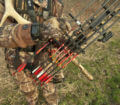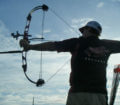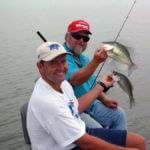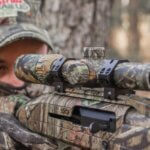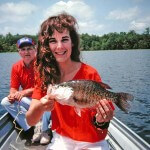Editor’s Note: With the start of bowhunting season only a couple of months away, you need to start practicing now. Frank Pearson of St. David, Arizona, owner and operator of the Frank Pearson School of Archery (www.frankpearson.com) and nationally-known archery coach, has seen the evolution of the bow from the longbow when he first started shooting and competed with up to today’s modern bows and most-technical bowhunting equipment. If anyone knows archery, and how to help an archer shoot better, you can rely on Pearson. This week Frank will give us practical tips on how to shoot better, whether you are a tournament archer or a bowhunter.
 Question: Frank, how long does your archery school last?
Question: Frank, how long does your archery school last?
Pearson: The school lasts for 2 days, and most of my students either work in the archery department of large sporting-goods stores, or they are owners of bow shops that they are about to open. These people must know how to fit their customers with the right weight bow and the right draw length. They also come to learn how to teach people how to shoot their bows accurately. They also need to know how to fletch arrows and make bow strings and cables. I also coach tournament archers who have won world championships.
Question: Frank, how big of a role does your mental attitude play in your ability to shoot accurately?
Pearson: If you have a bow that fits you pretty good, you haven’t taken any lessons on shooting the bow, you’ve bought a handful of arrows and a target, and every night when you’ve come home from work, you shoot 10 or 15 arrows in the back yard, then after a few months, you’ll be a pretty-good shot. After you reach that point, then the rest of the sport of archery and shooting accurately and consistently is mental. You need the strength to pull a bow back, and you need to make sure that somebody hasn’t sold you a 70-pound bow, and you only have a 50-pound bow body. The most-critical part of your mental attitude to shoot accurately is what you’re thinking about when you pull the bow back.
 Question: What should you be thinking about when you first start your draw, and what should you be thinking about all the way through drawing the bow?
Question: What should you be thinking about when you first start your draw, and what should you be thinking about all the way through drawing the bow?
Pearson: When you pull the bow back, if you’re concerned about taking a big-game animal or hitting a target, instead of being concerned about going correctly through your shot routine, then you’re in trouble. If you have a shot routine and go-through the four steps of your shot routine just as you start to draw the bow and all the way through your follow-through, you’ll be much-more successful and shoot more accurately than if you’re thinking about the target. Here are the four things I recommend that you do in your shot routine, depending on the equipment you’re using:
* Make sure your arrow is on the string properly.
* Be certain your arrow is on the rest properly.
* Make sure you’re looking through the peep sight and that the pin you’re using to aim with is in the center of the peep sight, when you draw the bow.
* Follow-through with your shot when you release the arrow.
If the bowhunter who comes home every day after work and shoots 10 or 15 arrows in the back yard, goes-through this shot routine every time he prepares to shoot an arrow, then he drastically improves his chance for success on every hunt. Most of the time when the hunter or the target archer misses, he or she hasn’t gone through the shot routine before the shot or has misjudged the distance to the target.
Question: Frank, how should the arrow sit on the string?
Pearson: Most archers today use a D-loop on their bow strings, and they attach a mechanical release to the D-loop, instead of to the string. Most of the time there is a little-more space in the D-loop than is required for the nock of the arrow. The reason for that space is because when you get the bow back to full draw, the angle of the string changes. So, you have to make sure your arrow fits tight on the string. I always put my nock at the top of the D-loop and then slide the nock up and snap it on.
 Question: How does the arrow need to sit on the rest?
Question: How does the arrow need to sit on the rest?
Pearson: If you are using a drop away rest, you have to make sure that the arrow is sitting on the drop away and not sitting on the shelf. If you get all excited because there is a great big elk in front of you, and you put the arrow on the shelf and not the drop away, then when you draw the arrow back, it still will be sitting on the shelf and not the drop away, and you’ll miss the shot. There is a certain way that the arrow needs to sit on each type of rest, and if you don’t make sure the arrow is sitting where it’s supposed to on the rest you’re shooting before you take the shot, you won’t shoot accurately. Some people shoot with a launcher blade that has the stem sitting-up and a V in the top of the stem. If you put the cock vein up on the rest, you will shoot accurately. But if you put the arrow on the string with the cock vein down, the arrow will come-out of the bow, the cock vein will hit the rest, and you will miss the shot. Therefore, depending on the type of rest you’re using, you have to make sure before you take the shot that the arrow is in the proper position for the kind of rest you have before you draw the bow.
Question: The third part of the shot routine that you mentioned was to make sure you’re looking though your peep sight before you take the shot. Then be certain the pin that you’re aiming with on the front of the bow is in the center of the peep sight. Is that correct?
Pearson: Absolutely. If the front pin is not right in the center of the peep sight before you release the arrow, you won’t shoot as accurately as you can.
Question: The fourth step of the shot routine is follow-through. Why is that so important?
Pearson: When you have the bow at full draw, and you’re preparing to take the shot, you want to make sure you have the equal amount of pressure with the hand you’re using to hold the bow and an equal amount of pressure of the hand you’re using to draw the string. If you don’t feel the same amount of pressure on your bow hand that you feel on the hand that has the release in it, you won’t get a good shot. I recommend that you have 2 pounds of pressure push on the bow hand and 2 pounds of pressure on the release hand. If you don’t have equal pressure on both hands before you take the shot, you can’t have a good follow-through, and the follow-through is critical for a good shot.
To learn much more about bowhunting, get John E. Phillips’ eBooks, print books and audiobooks by going to https://johninthewild.com/books.

